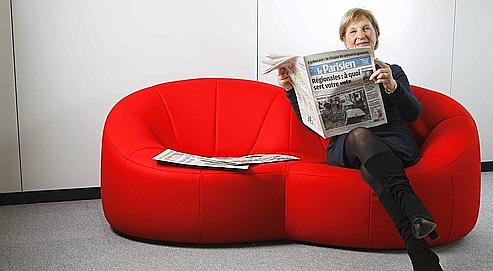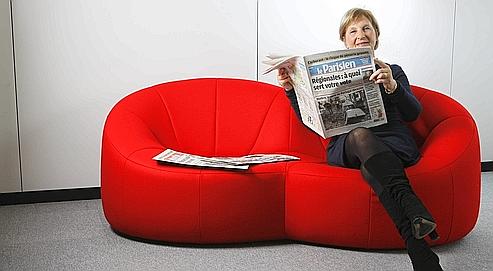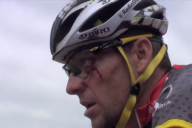In this sixteenth and concluding part of our series looking at aspects of the revenue-sharing debate, we close where we began, with the Amaurys. And in so doing we try to put a pretty ribbon around the positions being taken by two of the debate’s key players, ASO and the UCI.
Now that we’ve come to the end
I’ve been trying to piece it together,
Not that distance makes anything clearer.
~ Paul Muldoon
The story of the Tour de France began in Paris. Montmartre to be precise. That was where the offices of L’Auto-Vélo were located and where Géo Lefèvre first punted the idea that became the Tour de France. In order to put some symmetry on this thing, let’s draw this series of articles on aspects of the revenue-sharing debate to its conclusion by returning to Paris. Issy-les-Moulineaux to be precise. That’s where Amaury Sport Organisation is headquartered, next door to the offices of L’Auto‘s spiritual successor, L’Équipe.
Most days, the story goes, you’ll find the matriarch of the Amaury family dining in L’Équipe‘s staff canteen. While it is her thirty-something son, Jean-Etienne, who heads up the sporting arm of the family empire, it is Marie-Odile Amaury who is the Amaury Group’s chief executive. The buck stops with her. And, as a hands-on chief executive, she undoubtedly seeks to stay aware of all the bucks heading her way. She keeps a watchful eye over the affairs of ASO.
What does Amaury see today when she looks at ASO? She sees a Dakar Rally that is going from strength to strength. She sees a Tour de France that is back on an even keel. She sees ASO’s cyclo-sportif footprint growing, with the creation of new events like the Etapa Argentina and the acquisition of events like the Roc d’Azur.
But Amaury must also be aware of the storm clouds gathering on the horizon. There are the ever-present clouds of those who call for a greater share of ASO’s wealth, more money, a bigger slice of the cake, more crumbs from the table. Nor can Amaury be unaware of the threats posed by would-be sporting-magnates like Arnaud Lagardère.
Even if Lagardère proves to be the sort who would pull a gun in a fistfight, I’d like to think that the Amaurys would still be able to take the media-to-munitions mogul. They’re not without a few dirty tricks up their own sleeves, as Laurent Fignon discovered after he snapped up Paris-Nice from under their noses. But that is a fight that is unlikely to come to a single stand-up knock-down session. The Amaurys and Lagardère are digging in for a long war, an attritional war, each chipping away at the other bit by bit.
What of the other notable rival, the UCI’s new race-organising arm, Global Cycling Promotion? Could ASO take them? Fighting the UCI is not easy. Not because they don’t play by Marquess of Queensberry rules (the Amaurys can pay scant attention to them too, when the need arises) but because, as cycling’s sole governing body, the UCI ultimately write the rules and referee the fight.
The Amaurys – to their cost – know that fighting the UCI is not easy. I’m not just referring here to the ProTour Wars. There’s older history than that. Back in the eighties, when Hein Verbruggen set in motion the changes which would turn the UCI from being a toothless tiger into a force to be reckoned with, the organisers of the Tour attempted to halt him in his tracks.
Starting out as a marketing executive with the candy confectioner Mars, Verbruggen rose to power within the UCI’s professional arm, the Fédération Internationale du Cyclisme Professionnel (FICP), before – following the death of Luis Puig in 1990 – taking the helm of the UCI itself. While still with the FICP, Verbruggen took an idea from Vélo magazine and introduced the FICP World Rankings, which put a value on the head of every rider in the peloton, based on the points they accumulated over the course of a season.
Then Verbruggen expanded his power base with the introduction of the World Cup, supplanting the Super Pernod Prestige Trophy. FICP points became the key to gaining entry into the World Cup races. Félix Lévitan and the men of the Société du Tour de France saw Verbruggen’s initiative as being an attempt to stake a claim on sponsorship income, an attempt by the UCI to bring their own sponsors to others’ events. A move which would ultimately, they calculated, see the UCI muscle in on the TV revenues generated by the race organisers.
The Tour’s organisers became résistants, fighting the UCI with word and deed. In 1988, with the Société du Tour de France in turmoil as race directors fell like flies (three leaving in the space of just eighteen months) the Tour’s organisers even offered Verbruggen the gig that would neutralise the threat he posed to them: become Jean-Pierre Courcol’s replacement as director of the Tour de France. The men of the Tour know the truth of the old adage about keeping your friends close, your enemies closer still.
Hein Verbruggen, though, was not for turning and declined the offer from the Société du Tour de France. The World Cup ploughed ahead, eventually morphing into the ProTour before being rebranded as the WorldTour. For sure, the Tour’s organisers won some important skirmishes. The battlements around the Tour’s TV revenue withstood the brickbats the UCI tried to throw at them. And the World Cup was never successful at attracting its own sponsorship income.
A story for you: if you’ve ever worked in the media industry, there’s a trick you might be familiar with when faced with new rivals (or when threatening existing operators in the market): sponsors (advertisers) are advised or induced to stay away from the new kid on the block. The new kid is left to slowly wither away, expenses mounting up, reserves being run down, little or no income coming in. Eventually they fold and go away. Some people call this bullying. Others call it business. Whatever the name, it’s a trick that the Amaurys are not unfamiliar with, on both the media and sporting sides of their empire.
Whether this is why the World Cup singularly failed to attract sponsors, or whether the World Cup was just a pointless event that no one could see any merit in, well that’s a question that remains unanswered. But it was an attractive enough proposition when Pernod used to sponsor it. Back then, though, L’Équipe were supportive of the Super Pernod Prestige Trophy and gave it plenty of column inches.
All victories come at a cost. ASO were made to pay a price for their defiance. Showing his contempt for the sport’s traditional stakeholders, Verbruggen rode roughshod over them. One example: he added a time trial to the UCI-organised World Championships. In doing this he killed ASO’s end-of-season time trial, the Grand Prix des Nations. The UCI’s lesson was clear: don’t fuck with us.
Back to the present. The storm clouds on the horizon. What threat does Global Cycling Promotion pose to ASO, when all ASO’s races are within cycling’s traditional heartland? GCP is, after all, supposed to be charged with bringing bike racing to the rising economies of the BRIC countries (Brazil, Russia, India, and China). Where’s the beef in that?
The beef is that all of ASO’s races are not within cycling’s traditional heartland. ASO, for a long time, have been involved with developing cycling in Africa, through their Tour du Faso. That seems to have slipped quietly off the calendar this year. The why and the how I don’t know, perhaps someone reading this will tell me one day. But Africa is not the end of ASO’s international interests. ASO are partnered with AEG, the organisers of the Tour of California. They’re also helping to bring cycling to the Arab world, with the Tours of Oman and Qatar. And ASO partnered with Oman in their bid for the 2015 World Championships.
With ASO’s cyclosportif footprint expanding into Argentina on the back of the success of the Dakar Rally, can it be long before they set their sights on organising races in countries visited by the Dakar (Argentina, Chile and Peru)? Or look at Indonesia. Earlier this year ASO had advisors at the Tour of Singkarak (a 2.2 event, held in June). Advisors, fans of military history love to point out, frequently turn into boots on the ground.
So the UCI, through GCP, are not the only ones trying to expand cycling beyond its traditional borders. As ASO’s Christian Prudhomme pointed out a few months back, none of this is new for the Amaurys. “Riding a bike is universal,” Prudhomme explained during this year’s Tour, “but cycling competitively isn’t yet. We have to go everywhere […]. International development is important for ASO.” He then went on to highlight the history of the Tours of Oman and Qatar, before offering his audience another slice of history: “But this isn’t new to us. In 1954, four years before the foundation of the common European market, we organised the start of the Tour de France in Amsterdam, outside France. We went to Berlin in 1987 before the fall of the Wall, etc.”
The UCI can, at times, be thin-skinned and Prudhomme’s boasting might have been seen by some as a put-down of the UCI’s efforts to internationalise cycling. The UCI never took kindly to Dick Pound’s little barbs. And, in more recent months, they were stung by comments from USADA’s Travis Tygart having to do with foxes and hen houses. If the UCI and ASO were really entering into another petty little struggle for the soul of cycling, the UCI could easily have responded to Prudhomme’s braggadocio by reminding us of all the non-traditional nations they have sent the World Championships to down through the years. Or maybe they could have just pointed out that the reason the Tour went to Berlin had little to do with bringing cycling to the Communists and everything to do with capitalism: the good burghers of Berlin paid the Société du Tour a king’s ransom in order to entice them across the Iron Curtain.
But would the UCI waste their time fighting ASO with words when they can fight them with deeds? Time to recall a story told in the first part of this series. Back in 1946, when the post-Libération fight for title to France’s Grand Tour was going on, the UCI settled the first round by choosing Jacques Goddet’s Tour de France over its rival – Ce Soir‘s Ronde de France – for the calendar slot. Today, the UCI still have control over those calendar slots. Events can be shifted around the calendar to rival existing events. Or new events can meet considerable resistance in their attempts to gain a calendar slot. And, of course, old events can always lose their place on the calendar. While we would all notice were the UCI to attempt to remove the Tour de France from the calendar, how many of you had heard of the Tour of Singkarak before ASO sent advisors there?
So let’s ask the question again: what threat does Global Cycling Promotion pose to ASO? Some drippy hippy shit here: if a smile is just a frown turned upside down, then a threat is just an opportunity in disguise. Rather than asking whether GCP represent a threat to ASO, we should wonder instead whether GCP are really an opportunity. ASO and the UCI have, after all, kissed and made up since the ProTour Wars. And ASO have partnered with the UCI to bring cycling to the Chinese. Those aforementioned words from Prudhomme, they were made at the media launch of the Tour of Beijing.
But aren’t ASO still fighting with the UCI? Despite Marie-Odile Amaury’s edict that L’Équipe should give over banging on about doping and report news rather than make it, wasn’t it L’Équipe who broke the story about the UCI’s Index of Suspicion? Had the UCI done something to upset the Amaurys, causing them to respond in such an unkind fashion?
That Index of Suspicion story, how did it really hurt the UCI? Why, it hurt them by showing that they suspected certain riders of doping more than they suspected others! That really is utter balls. The Index of Suspicion was exactly what many in the anti-doping community have long called for: greater use of intelligence-based target testing, as opposed to inefficient blanket testing. Wasn’t this exactly how the AFLD and the FFC caused such a stir at the 2008 Tour, by profiling riders in advance of the race and then using those profiles to draw up a list – an index – of who the testers needed to pay the most attention to? Look at how successful that was.
The people who were hurt by the Index of Suspicion were the riders. Their teams felt the pain too. Because the cycling community saw the Index of Suspicion as being an Index of Guilt, rather that what it really was, an index of priority for the testers, partly based on something as simple as when a rider was last tested. Whoever gave that list the title of the Index of Suspicion was a clever little operator.
When did the Index story break? May time, wasn’t it? Not long after the AIGCP’s deadline for “drastic action” should the UCI fail to rescind the ban on race radios. That drastic action, we all knew even before the May Day deadline, was a boycott of the Tour of Beijing. A race organised by the UCI in collaboration with (among others) ASO.
Step back in time to just a few weeks before L’Équipe revealed the leaked Index. Recall that little strop some managers pulled, walking out of a meeting with the UCI. Some of the managers claimed that their walkout was spurred by the UCI trying to give them a history of the bicycle, which is always a contentious issue, with the French and the British going at one another, each claiming they got there first. Only for the Germans to get chippy at their contribution being overlooked. And all the while the Italians just sit there looking smug, knowing that they hold the trump card, some doodles in one of Leonardo’s notebooks. It’s usually around that time that the fists start flying. There are days when I actually admire Pat McQuaid.
The day after that meeting, L’Équipe carried a report of its proceedings, a report which claimed McQuaid had informed the managers that, thanks to the bio-passport, he held precise information on each team’s riders, before brandishing “the spectre of public revelations that would cause damage.” One AIGCP member, Roberto Amadio (Liquigas), disputed L’Équipe‘s version of events but in doing so seemed to confirm that McQuaid had in fact threatened them with the public revelation of a list of targeted riders.
And then, by one of those strange coincidences life throws up all the time, such a list of targeted riders happened to find its way into the hands of someone at L’Équipe. Someone who, despite Amaury’s edict to the contrary, banged the doping drum and made the news instead of just sitting back and reporting what others had uncovered. Did a head roll in L’Équipe that day? There’s more than enough blood on Amaury’s carpet to suggest that, had the Index of Suspicion story offended her, the journalists and editors responsible would have faced the guillotine.
Am I just peddling a conspiracy theory here, demonstrating that I read far too many thrashy thrillers? Of course I am. For the UCI were hurt by L’Équipe‘s release of the Index of Suspicion. They were cut to the quick. They were shocked – shocked I tell you – that someone could leak such a list, quite possibly someone in their own organisation. And so McQuaid promised to do a George Smiley and root out the traitor in the UCI’s ranks. Except, of course, that I see McQuaid as less like George Smiley and more like George Stroud, from Kenneth Fearing’s The Big Clock.
And so when I picture Marie-Odile Amaury sitting in her Issy-les-Moulineaux office, gazing out at the Paris skyline and the storm clouds gathering on ASO’s horizon, I don’t see her frowning when she views the cloud caused by GCP. I see her smiling. Happy in the knowledge that ending the ProTour Wars was – for ASO – the right thing to do, for in so doing she finally enabled ASO and the UCI to unite in a common purpose: sharing the revenue to be generated by the global expansion of cycling.
And I see her smiling, happy in the knowledge that Hein Verbruggen has left the stage and gone off to play World Mind Games with his new toy, SportAccord. But look closely at that smile. Is that a frown forming at its edges? SportAccord is, after all, just a new stage from which Verbruggen is waging his war to allow sports’ international federations to seize control of the TV revenues generated by their sports. The battlements around the Tour’s TV revenues are already being reinforced in preparation for Verbruggen’s next assault.
















1 Comment
[…] Next: Paris – the end of the road (for now). […]